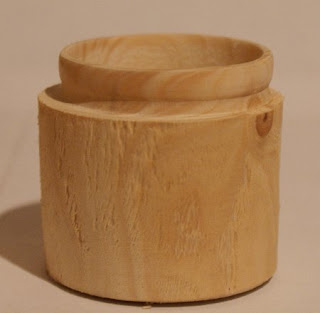If you visit regularly you'll know that I like to make various turned wood boxes, be they memory boxes, needle cases and all the other stuff as well.
Now I have for sometime now made the lids in the same way (more or less) like in my latest piece, it's a very basic way to do things.
Here's the latest box -
 |
| Pointy box. |
The lid basically fits inside the body of the box, probably the easiest way possible.
You can see how it fits into the box -
 |
| Simple, but it works. |
And that's as complicated as it gets, the lid sits in the body of the box, and the little extra bit stops it from sliding off, I do tend to make them a tight fit, but as it's wood it doesn't always stay tight, and sometimes it gets tighter, so what to do about it ?
Well I have experimented with various ways of securing the lids, the first thing I tried is a click fit lid, it involves making a rim on the lid that fits into a gap in the body of the box.
The click fit lid -
 |
| You can just make out the shape. |
The box body -
 |
| The lid clicks into the body of the box. |
The lid then clicks into the gap in the body, with a click oddly enough, and this it seems is a good way to stop the lids coming off the body, this is good if you've got needles or other items in the box, how ever it does take a fair bit of time (at least for me) to get it all lined up, and if the wood happens to shrink a little or indeed expand you can end up with the same issues, either too tight or not tight enough.
And that's when I started to think about rubber, or more specifically rubber rings ('O' rings) lots of different types of storage use a rubber seal of some kind, so I decided to try a similar thing.
'O' rings -
 |
| Not sure why they are popular, maybe they asked a plumber. |
It's handy to have them around anyway for fixing leaky taps -
 |
| Small rubber rings. |
|
|
To get the rings onto a box lid is pretty easy, I just turned the lid and box as I normally would, but with the addition of a small groove, which the O ring sits in, this seems to allow for a good secure fit, but the tightness of the lids seems to stay pretty constant, even if the wood shrinks or expands a little, as the rubber also expands and contracts with the wood.
So far I've tried two boxes with this idea, one with the rubber ring on the lid, and one with the rubber ring on the box body, both ways seem to work well, which is good as the two pots are both for storing pins, and they both have a built in pin cushion.
This Pear wood pot has the rubber ring on the lid -
 |
| The rings fit well. |
And as you can see even if I hold the box upside down the lid stays on -
 |
| No spillage here. |
The next box is made from Cherry, and has the rubber ring on the box body, rather than in the lid, again it works just as well.
Here's a picture of the groove ready for it's rubber seal -
 |
| It's easy to make the small grooves. |
Rubber seal fitted -
 |
| All ready. |
And now the upside down test -
 |
| Another success. |
I'll no doubt keep experimenting with this and other methods of making these boxes a touch more secure, I have plans to make a lockable one, all be it with a simple lock.
Here are the boxes the right way up -
 |
| Cherry with a velvet cushion. |
 |
| Pear with a velvet cushion. |
Thanks for reading.




















Nice.
ReplyDeleteHave you thought about using magnets?
I can't say that I have, but thinking about it, it would be fairly easy to use a few neodymium magnets to keep the lids on.
DeleteVery clever. Your work looks beautiful. I wish I were more handy with that sort of thing as I'd love to craft with wood.
ReplyDelete